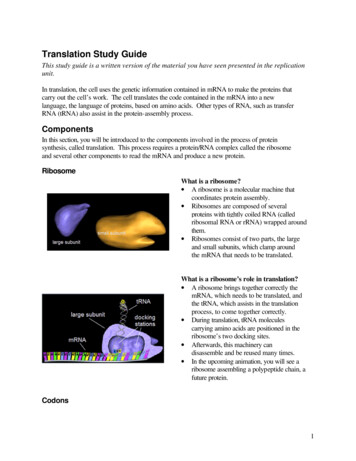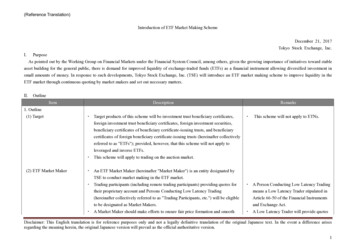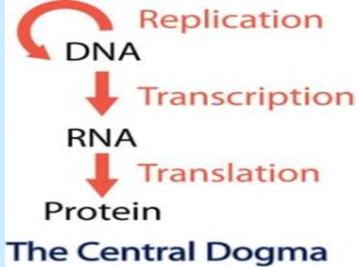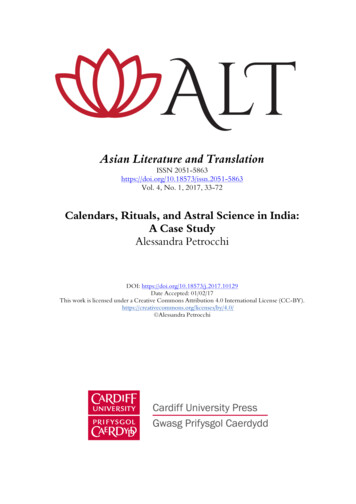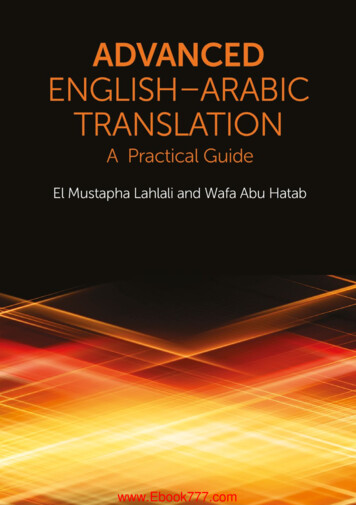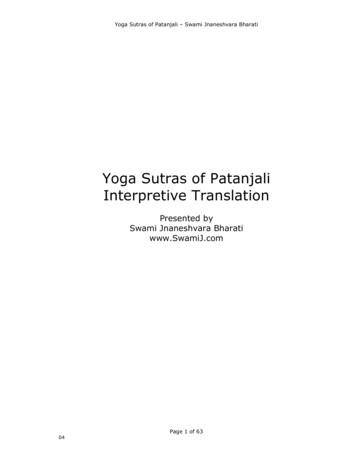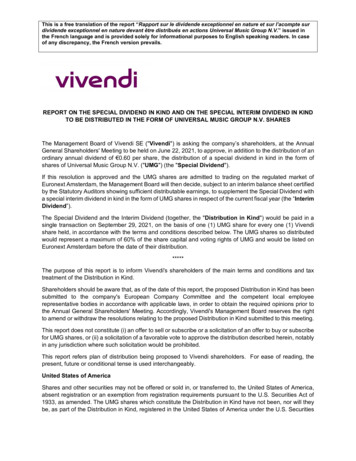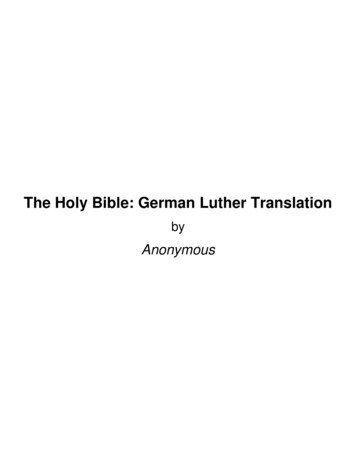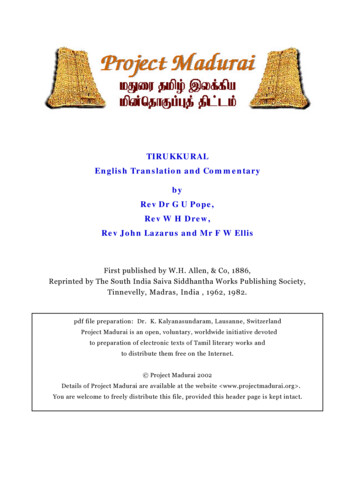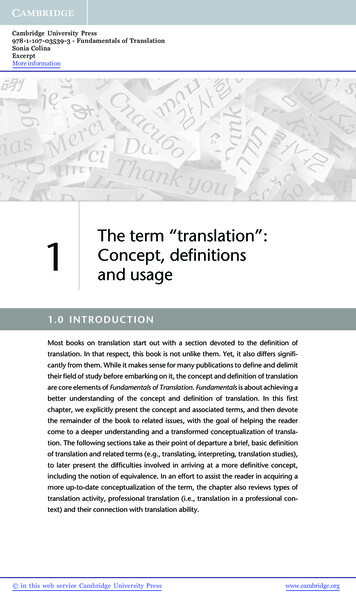
Transcription
Cambridge University Press978-1-107-03539-3 - Fundamentals of TranslationSonia ColinaExcerptMore information1The term “translation”:Concept, definitionsand usage1.0 INTRODUCTIONMost books on translation start out with a section devoted to the definition oftranslation. In that respect, this book is not unlike them. Yet, it also differs significantly from them. While it makes sense for many publications to define and delimittheir field of study before embarking on it, the concept and definition of translationare core elements of Fundamentals of Translation. Fundamentals is about achieving abetter understanding of the concept and definition of translation. In this firstchapter, we explicitly present the concept and associated terms, and then devotethe remainder of the book to related issues, with the goal of helping the readercome to a deeper understanding and a transformed conceptualization of translation. The following sections take as their point of departure a brief, basic definitionof translation and related terms (e.g., translating, interpreting, translation studies),to later present the difficulties involved in arriving at a more definitive concept,including the notion of equivalence. In an effort to assist the reader in acquiring amore up-to-date conceptualization of the term, the chapter also reviews types oftranslation activity, professional translation (i.e., translation in a professional context) and their connection with translation ability. in this web service Cambridge University Presswww.cambridge.org
Cambridge University Press978-1-107-03539-3 - Fundamentals of TranslationSonia ColinaExcerptMore information2The term “translation”: Concept, definitions and usage1.1 Translation, translating and translation studiesAs illustrated by the examples in Example 1.1, the term translation can refer to anactivity, a product and the scholarly field that studies both the activity and theproduct(s). This book will deal with the first two, namely, the product (translationor translations), and the activity or process that produced this product(s) (alsoreferred to as translating). The distinction between the process and the product isnot always clear-cut, as the two concepts often overlap, whereby it can be difficultto draw a clear line where the one ends and the other begins.Example 1.1: The term “translation”1. Product. The brochure was a translation from English, so it did not work wellin the Russian market.2. Process. The interns were working on a translation of the letter from theprincipal to the workers.3. Field. Translation is sometimes considered an area of applied linguistics.(For additional practice with these concepts, see Exercise 1 and Exercise 2 inthe Exercise section at the end of this chapter.)The scholarly field that studies translation and interpreting and related phenomena is known as translation studies. The name was first coined by Holmes(1988) and has since become established wherever the field is cited. In the last fewyears some degree of confusion has arisen, however, with regard to the nametranslation studies. As interest in translating and interpreting grows, teachingand training programs of various types have become common in universities andother educational institutions. With the rise of area studies and cultural studies, itseemed logical to some to simply apply the same template to translation andinterpretation, and refer to any program dealing with translation and interpretation as a Translation (and Interpreting) Studies program. Unfortunately, in somecases the label was applied (often by well-intended administrators, clearly notfamiliar with the field) to programs whose primary concern is the training andeducation of translators and interpreters (i.e., the practice of translating and/or in this web service Cambridge University Presswww.cambridge.org
Cambridge University Press978-1-107-03539-3 - Fundamentals of TranslationSonia ColinaExcerptMore informationPreliminary definition: Basic concept3interpreting), with little or no reference to the scholarly field itself. Within thetranslation studies field, these areas are normally specified and referred to astranslator and interpreter training or education (T&I). Degrees from such programs are frequently called an “MA in Translation,” perhaps with a languagespecification, while advanced theoretical degrees may be titled “PhD in translationstudies.”As mentioned in the Preface, this book is not about translation studies per se,although it draws from current knowledge in this field, as well as from otherrelevant disciplines.1.2 Preliminary definition: Basic conceptThis book takes as its point of departure a basic, preliminary definition oftranslation:Translation refers to the process of, or the product resulting from, transferringor mediating written text(s) of different lengths (ranging from words andsentences to entire books) from one human language to another.This preliminary definition attempts to capture the essence of the concept oftranslation, i.e., the core elements that most scholars and practitioners will agreeare present in the concept of translation: (i) written text; (ii) transfer; (iii) fromone natural language to another, as summarized below.Core elements of translation(i) written texts(ii) transfer or mediation(iii) from one natural language to anotherIt is important to stress that translation deals with the transfer of written text.When the text or the medium is oral, however, the term used is interpreting orinterpretation. In lay circles, one can sometimes hear the terms translation andtranslator being used to refer to interpreting and interpreter, with no distinction being made with regards to medium. In other areas, also, Translation with acapital “T” can be used to refer to both translation and interpreting as forms of in this web service Cambridge University Presswww.cambridge.org
Cambridge University Press978-1-107-03539-3 - Fundamentals of TranslationSonia ColinaExcerptMore information4The term “translation”: Concept, definitions and usagemediation, whereas translation with a lower-case “t” means translation. Thisbook follows common usage in T&I, in which the oral vs. written mediumestablishes a distinction with regard to field and practice.In translating, the language from which a text is translated is known as thesource language (SL) and the language of the translated product is the targetlanguage (TL). What is also referred to as the original text is generally known asthe source text (ST) and the translated text is the target text (TT). For instance, ina translation of Shakespeare’s Hamlet into Spanish, the ST would be the Englishoriginal text and the Spanish translation the TT (see Exercise 3 for moreexamples of ST and TT). Practice 1.1 contains an example with commentarythat will help you test your understanding of the notions SL, TL, ST and TT.Practice 1.1: On SL, TL, ST and TTConsider Figures 1.1, 1.2 and 1.3. What would be the SL, TL, ST and TT for eachone of these figures? You may need to infer some information based on thetexts.CommentaryUpon examination of the texts, you will see that all three figures are translations (commissioned by the Centers for Disease Control and Prevention).Therefore, the languages they are written in are the TLs, namely, Chinese(Figure 1.1), Vietnamese (Figure 1.2) and Russian (Figure 1.3). Consideringwho commissioned the translations, we can safely assume that the languagethat they were translated from is English; therefore, the SL for Figures 1.1, 1.2and 1.3 is English. Each figure contains one TT, in each of the TLs. The ST isnot provided.Figure 1.1Figure 1.2Figure anST(not shown)(not shown)(not shown)TTFigure 1.1Figure 1.2Figure 1.3 in this web service Cambridge University Presswww.cambridge.org
Cambridge University Press978-1-107-03539-3 - Fundamentals of TranslationSonia ColinaExcerptMore informationPreliminary definition: Basic concept5Figure 1.1 Determining the SL, TL, ST and TT. in this web service Cambridge University Presswww.cambridge.org
Cambridge University Press978-1-107-03539-3 - Fundamentals of TranslationSonia ColinaExcerptMore information6The term “translation”: Concept, definitions and usageFigure 1.1 (cont.) in this web service Cambridge University Presswww.cambridge.org
Cambridge University Press978-1-107-03539-3 - Fundamentals of TranslationSonia ColinaExcerptMore informationPreliminary definition: Basic concept7Figure 1.2 Determining the SL, TL, ST and TT. in this web service Cambridge University Presswww.cambridge.org
Cambridge University Press978-1-107-03539-3 - Fundamentals of TranslationSonia ColinaExcerptMore information8The term “translation”: Concept, definitions and usageFigure 1.2 (cont.) in this web service Cambridge University Presswww.cambridge.org
Cambridge University Press978-1-107-03539-3 - Fundamentals of TranslationSonia ColinaExcerptMore informationPreliminary definition: Basic concept9Figure 1.3 Determining the SL, TL, ST and TT. in this web service Cambridge University Presswww.cambridge.org
Cambridge University Press978-1-107-03539-3 - Fundamentals of TranslationSonia ColinaExcerptMore information10The term “translation”: Concept, definitions and usageFigure 1.3 (cont.) in this web service Cambridge University Presswww.cambridge.org
The brochure was a translation from English, so it did not work well in the Russian market. 2. Process. The interns were working on a translation of the letter from the principal to the workers. 3. Field. Translation is sometimes considered an area of applied linguistics. (For additional practice with these concepts, see Exercise 1 and Exercise 2 in the Exercise section at the end of this .
